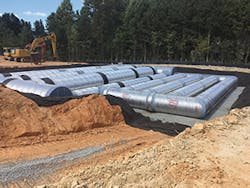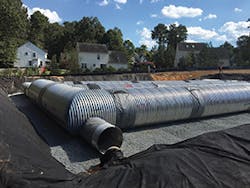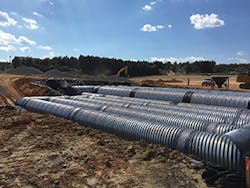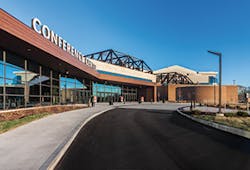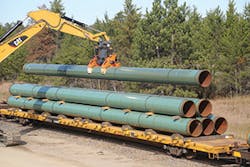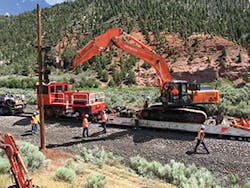A quick perusal of once-popular English literature would show that the Victorians, and indeed a century of their predecessors, were eager to adopt any innovations to improve drainage. While most agrarian societies fought weather, taxes, and landlords to keep crops in the field, drainage for them and the estate managers was key to “turning profitless waste into land fit for tillage and pasture.” On the other hand, crowded urban dwellers were repulsed by the lack of conveyance to remove standing water, rain, and sewage; the term drainage (and the lack of it) for them connoted entirely different circumstances.
Without the seemingly limitless expanse of land in the US, Britain and small European countries devised ingenious plans to drain land for profitable use. Looking back today on some of those Victorian novels whose droning prose on the dilemmas of drainage bored most of us into oblivion as we waded through years of requisite reading, we can now appreciate the immense challenges of earlier engineers and landowners.
Then as now, drainage for the landowners presented a simple choice between profit and loss. While this still holds, today the stakes are higher and far more complicated. Regulations, human safety, public health, transportation access, environmental conservation, and more are the measures that guide drainage efforts.
And we have something our ancestors didn’t: tough and durable piping systems made from the latest formulations of concrete, plastics, and engineered corrugated steel.
Dutch Determination Demands the Best
Holland, MI, located in Ottawa County on the east side of Lake Michigan about two hours north of Chicago, was originally founded by Dutch Calvinist separatists. Settling in the 1840s near the Black River that streamed to Lake Macatawa and led to Lake Michigan, they established a First Reformed Church and founded Hope College, which was chartered by the state in 1866.
John Tenpas, civil group manager with Driesenga and Associates in Grand Rapids, MI, describes the latest project to create a new home to the school’s musical arts program, the building of the Jack Miller Center for Musical Arts. “The goal was to move the music facility to a vacant site that the college had purchased from the city with the help of significant private donors. Driesenga played a very important role in geotechnical services. “We led the site design effort with evaluation of site soils and recommendations for foundations, floors, retaining walls, and excavation stability.”
He adds that the comprehensive evaluation was crucial because the site had been vacant and planning, literally from the ground up, was necessary to address the significant increase in runoff volume that would be created. Another aspect was the overarching concern for the appearance of the project.
“It was very important that all the drainage and stormwater systems were virtually invisible. The aesthetic of this project was paramount, and we had to come up with unobtrusive but effective drainage features,” says Tenpas. He notes that the facility faces the street, and with “thousands of cars passing each day, high pedestrian traffic, and a wide range of performances, we didn’t want to mar the aesthetic presentation with drainage features such as round iron castings and typical drainage elements that would detract from the stunning brick and glass façade.”
The new 43,000-square-foot center has an acoustically superior concert hall that seats 800, as well as offices, classrooms, practice rooms, and rehearsal halls. The civil engineers successfully accommodated both drainage and appearance demands. They developed a grading plan that accommodated the architect’s vision to include barrier-free ramps and short knee walls, with water managed through a 300-foot trench train.
“We used Brickslot from ACO Drain, which is a very discreet drainage solution,” says Tenpas. “One of the concerns we had was keeping the area free of water and snow while at the same time using a product that was smooth. You don’t want people in dress shoes getting caught in typical drain surfaces, nor have them slip on snow or ice buildup.”
Tenpas says that the Brickslot trench drain was installed in five sections, with the longest being 114 feet and the shortest about 32 feet. These were positioned under pavers where the land was graded to slope away from the building. The collected water is conveyed to an underground retaining system, which ties into the city of Holland’s stormwater system. The drain is virtually invisible.
“A trench drain is an old concept, but we have new technology to deploy,” he says. “Basically, you dig down into sand, which can be from 8 inches to several feet deep, and you have U-shaped pipe, and these connect together with the stainless steel Brickslot catch product over it. When it’s installed, the slot is very thin—less than an inch wide—and it is positioned between the paver joints. It’s barely visible, and water drains into this slot and off the surface very quickly.”
ACO spokesperson Jaclyn Revis describes the durability of what’s not seen underground. “The modular trench that the Brickslot fits over between the pavers comes in 2- to 12-inch internal widths, and these are available with up to 130 feet of built-in continuous slope. These trench drains underground are made from either corrosion-resistant polymer concrete, a durable material made of polyester resin reinforced with mineral aggregates and fillers, or fiberglass, depending on the application.”
But in any case, they’re tough enough to handle the demands of anything from the light surface traffic of pedestrians to the weight of jumbo jets on airport surfaces.
Looking very much like a long mail slot on the surface, the stainless steel product conveys water to the U-shaped pipes below, then to “a storm retention system that first has an isolator row where sediment settles out, and as that fills up, the water rises and is stored in a chamber, which then exits to the city stormwater system,” explains Tenpas. “Everyone loves this product and how it solved our drainage collection in a manner that is completely unobtrusive. The architect and the building owners are thrilled at the result.”
The Allen County War Memorial Coliseum
Keeping the Public Safe
One of northern Indiana’s largest architecture and engineering firms, MSKTD and Associates, was recently tasked with solving the drainage problem of a local community centerpiece, says engineer Kerry Schoeph. He relates the success of the project for the Allen County War Memorial Coliseum in Fort Wayne, IN. While the term “war memorial” typically conjures an image of a bronze pedestal and saber-brandishing military figure on a dynamic horse, Allen County’s is a very different kind of war memorial.
Voted into existence by taxpayers in 1946, the founding mission stipulated that the Memorial Coliseum be a “living memorial,” a venue to bring mixed-use events and entertainment to the public, thereby ensuring its existence in perpetuity as tribute to all war veterans. The current Coliseum, Schoeph says, is Fort Wayne’s major event center and can hold an audience of 8,000 to 10,000 visitors.
“We have a number of public events, such as basketball games, hockey, and entertainment headliners, and the Memorial needed to update its main entrance to accommodate ADA [Americans with Disabilities Act] issues and create better drainage for public safety.”
Schoeph says his firm became involved to design a means whereby water, snow, and ice would not endanger visitors. “At the same time, the owners wanted the entrance to be like a plaza so that visitors would not have to step up on a curb, and to make it easier for events like farm shows where exhibitors bring tractors or combines that can be displayed on the plaza.”
The designers chose to make the entrance ADA friendly by making the walkway flush with the adjacent drive. The plaza incorporates a snowmelt system to eliminate the need for salt and chemicals.
“We used a polymer concrete trench drain between the drive and parking lot,” he explains. “When it rains, or when the ice and snow melts, the trench drain catches that runoff, which in turn is discharged into the underground storm system.”
He adds that installing the underground snow melt system (a series of continuously flowing, heated glycol- and water-filled pipes below the surface) also helps water quality by reducing the introduction of pollutants to the storm sewer system.
In total, Schoeph says, 286 feet of ACO S100K trench drain was used. The 6-inch-wide, U-shaped drain is made of polymer concrete and has a 4-inch, ADA-compliant slotted iron surface grate. The drain conveys runoff to a 24-inch main pipe.
“It’s more than just a storm drain,” he notes. “It serves to collect the snow melt and get it away and keep the public safe.”
This completed project, Schoeph says, “blends well with the large 62,000-square-foot conference center adjacent to the Memorial that we had recently completed.”
The Deckhand mounted on an excavator
No More “High Anxiety”
Sitting in busy city traffic watching the latest high-rise building project while a nearby crane picks up a load of pipes and swings them over to the job site might be just a little unnerving. But Jason LaValley, CEO of Minnesota-based LaValley Industries and inventor of the Deckhand pipe-handling system, says his innovations can put everyone’s mind to rest. He explains that his in-the-trenches experience and witnessing an employee’s tragic injury in the directional drilling industry were more than enough incentive to find improvements.
“During my onsite work I witnessed numerous accidents as workers handled the dangerous task of unloading and loading drill pipe, acting as human deckhands. Guys were getting injured, some pretty seriously, with broken hands, broken legs, pinched fingers, and more, and I kept thinking, with the technology of the 21st century, why don’t we have better tools to do these jobs?”
He says the last straw occurred when one of his crewmembers got his leg caught between pipes and his ankle was crushed.
“That night I sat down and sketched out the concept for the Deckhand, and as they say, the rest is still making history.”
Today, the Deckhand, and its interchangeable and customizable arms, is used on job sites all over the world. LaValley says the Deckhand “mounts to any brand of excavator, and the operator in the cab of the excavator controls all functions.”
He adds, “The Deckhand can grab anything from 4-inch- to 56-inch-diameter pipe and has special wear pads that protect the pipe coating. You can use this for any application where you need to pick up pipes—steel, concrete, you name it. The lift is absolutely secure, with no swinging or lateral movement.”
And because of integrated safety features, such as load control valves, pipe is never dropped, regardless of the hydraulic pressure. “You pick up your load and put it where you want it, just like a hand—hence the name Deckhand,” he says.
The danger of handling pipe is just one of the problems workers face onsite. “Take the dilemma of exit side operations during horizontal drilling,” he says. “When drilling under a river or roadway, for example, the drill rig rotates the pipe, but when you get to the other side, how do you get the pipes apart?”
LaValley invented the Tonghand exit side wrench for just this purpose. Nicknamed “Rig on a Stick,” the Tonghand can be used as a vise and pipe handler to easily make and break pipe joints with up to 120,000 foot-pounds of torque. Like the Deckhand, it can be attached to any brand of 30- to 36-metric ton excavator.
With its patented roller arms and shift function, operators can both thread and unthread all drill pipe connections directly from inside the unit. He says that the tool can do in 8 to 10 minutes in what could take 30 to 45 minutes of work for a crew to perform, while vastly reducing the risk of personnel injuries.
Although other products are available for handling pipe, says LaValley, “There are not many people who are designing for the industry who actually are guys from that industry. I’ve seen the hardships, the safety hazards, and the efficiency problems, and I try to address them all when designing our products.”
Honoring an American Legacy
Henrico County, VA, has more than 400 years history to boast about in the settlement of the US. A new housing development there is named for one of the earliest founders. John Rolfe, who left England in 1609, is remembered, among other things, as the former husband of Pocahontas. Notably, he was also the founder of a significant American enterprise that was key to saving the colony from financial ruin—Virginia tobacco.
According to Jonathan Jackson, director of engineering with Henrico County-based Bowman Consulting, a recent project successfully addressed the challenges of both a complex site and complex state and local stormwater regulations.
“Our client, Markel|Eagle, had a 10-acre property they wanted to develop into 40 single-family units, and as civil engineering site development specialists, we were contracted for those engineering services,” he explains. “This site drains to the James River watershed and is subject to both the relatively new Virginia Runoff Reduction Method criteria and the county’s 50-year post-development/10-year predevelopment stormwater detention requirements.”
Jackson explains that the undeveloped property had more than 30 feet of fall across the site, and engineers needed to address the public’s concerns that stormwater runoff could potentially affect the surrounding established neighborhoods.
“While the underground detention system that is in use is a more complex solution at the outset, in fact we think this is a better long-term solution for the property’s stormwater management and the aesthetics for residents,” says Jackson.
LaValley Industries’ Tonghand
Typically, the county requires an aboveground conventional sediment basin that is maintained until at least 80% of the homes at a site are developed. But as Jackson notes, this can become a problem “because you have a large muddy pond that collects water and sediment and is generally unattractive while the property is being developed and visited by potential buyers.” The aboveground pond also eats up valuable land that might otherwise be used as a homesite or community space.
Moreover, when the property reaches the 80% level of development, heavy equipment must come in to drain and fill in the sediment basin, which is another messy and intrusive undertaking.
“So by putting in underground detention that can serve as both a temporary sediment basin and then a permanent storage area, we eliminate those headaches,” says Jackson.
Using a combination of concrete, plastic, and corrugated steel pipe products from Lane Enterprises, the project designers came up with solutions that not only freed up land but “also eliminated a sediment basin from being exposed to public view,” notes Lane Enterprises regional engineer Ken Freeman.
“Our underground pond can hold a lot of water in this 88- by 70-foot space,” he says. “In terms of erosion and sediment control, our pond compares to an aboveground pond in that it holds the same volume, provides for drainage, and the sediment can settle out. But it’s better than aboveground because its not exposed to wind and rain to stir up the water, or potentially overrun the banks.”
Jackson describes the route of runoff through the system. First, rain and runoff are collected via standard drop inlets, he says, and then conveyed to a concrete pipe that feeds to a Lane Filtration Chamber. “This first flush of water passes through this multiple-chamber filtration of geotextile fabric and stone, which removes trash and other large particles. Then, as that water builds up, it infiltrates into the surrounding backfilled aggregate and then back in through the perforations into a series of connected 8-foot-diameter perforated corrugated steel pipes.”
As the water stages up within the 8-foot-diameter pipes, it is released at appropriate rates through downstream flow control structures.
Freeman adds that very porous, uniform-sized bluestone gravel was selected to use as backfill, and a stone-shooter conveyer was used to deliver and fill around the steel pipes, ensuring proper drainage and preventing damage to the corrugated pipes during the backfilling operations.
Jackson says about 3,800 tons of this stone was used around the multiple corrugated steel pipes, which were placed in two underground pond structures engineers named Alpha and Beta.
“We needed a large space to handle the anticipated runoff for the size of this site, and there wasn’t one place to establish a single underground pond, so we needed to utilize two basins,” he says. “Alpha uses solely 8-foot-diameter corrugated steel pipes, and Beta has 5-foot and 8-foot pipes. All are aluminized steel, which offers substantial corrosion protection and long service life.”
Large-diameter steel pipes offer certain flexibility, Freeman explains, “as you can do any geometry you want, and corrugated steel fabrication allowed us to provide a tailor-made system that is very economical. Other products have certain limitations that can make installation, repairs, or modifications cumbersome or bulky.
“Since we needed very large diameters, and plastic price increases dramatically once you get above 5-foot diameters, corrugated aluminized steel was perfect. We get our sheet product from AK Steel of West Chester, OH, who offers the different coatings, and then we manufacture the pipes at Lane Enterprises, adding the corrugations before forming the pipe on a spiral pipe mill. All of the fabrication was done at our Bealeton, VA, plant and sold through Colonial Construction Materials, a local dealer of our products.”
Jim Evans, senior research engineer at AK Steel, offers a look into the backstory of corrugated steel pipe. “For our corrugated steel pipe customers, AK Steel primarily uses our electric furnace located just north of Pittsburgh in Butler, PA, which uses 100% scrap—that is, recycled—steel, to create the first step of slab steel,” he explains. Next, he says these slabs are transported to Middletown, OH, outside Cincinnati, “where they are hot-rolled, then pickled to remove scale, and then cold-reduced to the final customer thickness. Last, we then hot-dip-coat this at our Middletown works.”
Evans explains that in 1899, the Middletown facility was the site where George Verity founded the flagship facility for the original steel company, then called American Rolling Mill Company, known later as ARMCO and now as AK Steel.
After reaching customer-specified thickness, the product is known as Aluminized Type 2 Steel, which was originally developed by ARMCO. “The steel is coated in commercially pure molten aluminum with 1.5 mils coating on each side, after being continuously annealed in a reducing atmosphere. These coils of coated steel are then shipped to our customers that manufacture and corrugate pipe for culverts, storm drains, and detention systems. Corrugated coated pipe products are then used by their customers to solve the very important environmental puzzles to responsibly manage stormwater and groundwater,” says Evans.
Jackson says that when the development is finished, the surface area of Alpha will be a community public space, while Beta will have an overlying rain garden that drains downward to the corrugated systems, “which is why we used the smaller-diameter corrugated pipe in that section.”
When benchmark of 80% development is reached, which Freeman anticipates in about two years’ time, the underground detention basin will be flushed and cleaned via vacuum truck, then the temporary bulkhead panels of the filtration collectors, “which we installed to block off the perforations of the pipes for the short term,” will be removed. “Once the panels are removed, everything will flow to Alpha and Beta, allowing a permanent functioning of the drainage and stormwater management as planned.”
It’s a good bet that Downton Abbey’s Lord Grantham would have eagerly traded his gold chain of office for some geotextile and corrugated pipe to manage drainage on that 5,000-acre estate!
“Commissioners appointed to take evidence from local inhabitants were required to collect statistical data on the size of the population, the extent of the arable, the number of animals in the village, the amount of common, the number of houses claiming common rights, and the number of commoners depending solely on their common rights for a living. Contemporaries recognized more clearly than later historians have done that the key to many an agrarian problem was the relationships between the size of the population and the supply of land.”
From English Peasant Farming: The Agrarian History of LIncolnshire from Tudor to Recent Times, Joan Thirsk, 1957.
